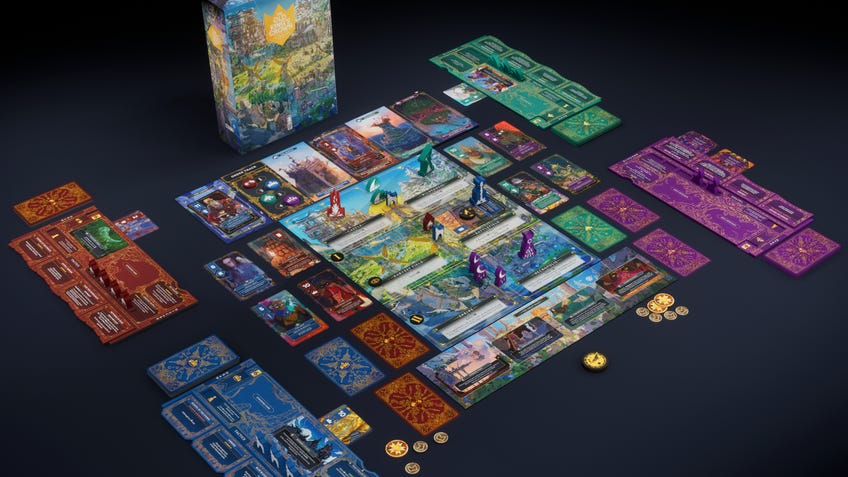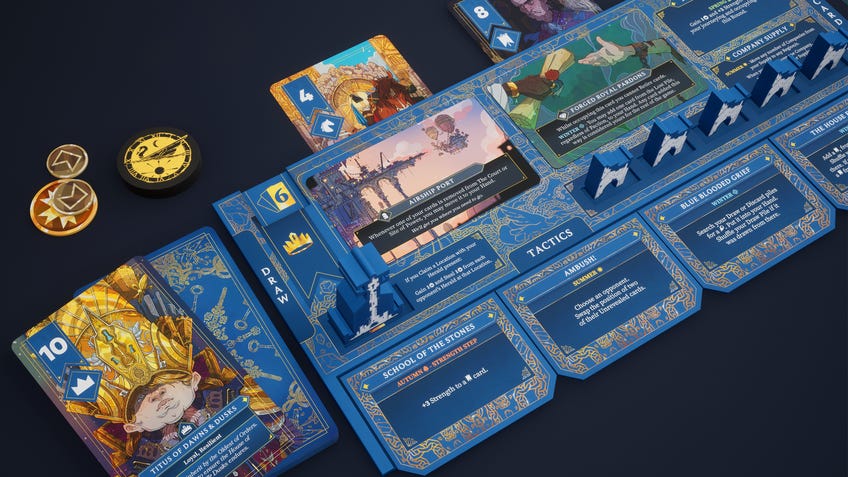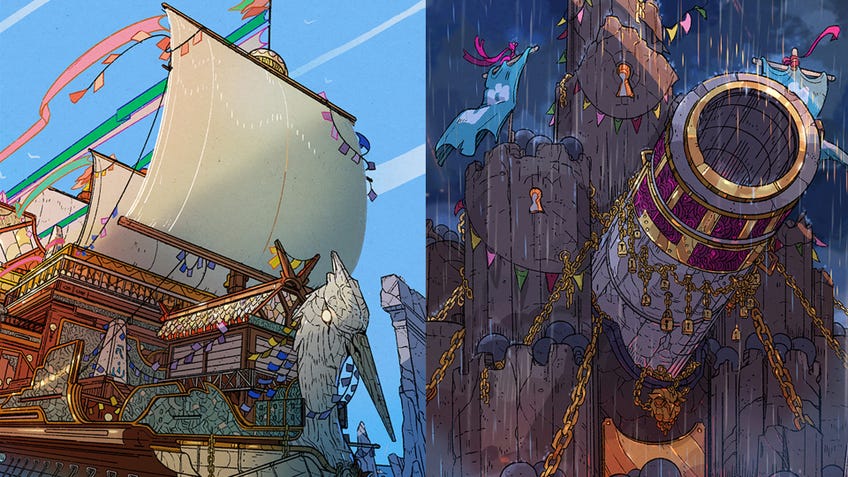A rich mix of Magic: The Gathering, Oath and auction games, The Old King’s Crown is already my most anticipated board game of 2024
The political subterfuge of Game of Thrones meets the ruthless combo-making of your best MTG deck.
The Old King’s Crown is a fascinating game. On its face, it resembles something akin to the regional scuffles and fantasy throne-wrestling of Root creator Cole Wehrle’s strategy masterpiece Oath: Chronicles of Empire and Exile. (Little surprise there: Oath itself is cited as a key influence on the design, with Wehrle and the team at publisher Leder Games helping polish its gameplay to boot - as shining a stamp of approval as any debut game can get.)
While there is a good bit of Oath in the mix, designer-illustrator Pablo Clark’s design is far more than a tribute act to Wehrle’s generations-spanning game depicting the ebb and flow of power in a fantasy kingdom. In motion, The Old King’s Crown brings together a staggering spread of ideas ranging from the potent card combos of Magic: The Gathering to the competitive blind bidding seen in classic auction games like Modern Art or For Sale.
Impressively, The Old King’s Crown’s ambitious mix of ideas never becomes too turgid or trite, blending its many familiar gameplay elements into a surprisingly smooth formula that feels deliciously fresh and fast-flowing - aiming to play in well under two hours even with a full table. Combined with Clark’s jaw-dropping artwork and tantalising glimpses of a mysterious fantasy world, The Old King’s Crown sharpens up a delightfully cut-throat competition of competing factions and ruthless cardplay that has quickly made it my most anticipated release of next year.
The game plays out in rounds that thematically represent years in the realm’s turbulent history. Spring sees players assign their heralds - singular wooden tokens that put me in mind of Oath’s own meeples - to individual locations split across the board’s three regions: the highlands, plateau and lowlands. Placing a herald grants an additional bonus, gaining you a bonus VP-like influence (you’ll need to amass a certain amount to win, depending on the number of players) and stealing one off a rival player if they’re also present.
The underlying bluffing and social manipulation takes The Old King’s Crown from being a fetching strategy game to something far more complex and engrossing.
That potential advantage can cheekily be used instead to misdirect players into thinking you want somewhere more than you actually do - teasing at the underlying bluffing and social manipulation that takes The Old King’s Crown from being a fetching strategy game to something far more complex and engrossing, and worth the attention of anyone looking for clever, boundary-pushing tabletop experiences.
Where you choose to pursue in the kingdom becomes especially important as each location grants a specific ability to its controlling player later in the round - you will need to fight for it, mind. In summer, players assign one card from their hand to each of the three regions. Crucially, these cards are placed facedown, before being revealed and resolved in autumn; the player with the highest strength takes control of the region and gains access to one of its locations.

The hidden element makes the heart of The Old King’s Crown more of an abstracted auction game than anything else, with cards’ abilities and the differing powers of each player all contributing to the central wrestle over control of valuable locations. While some card effects trigger when they’re revealed, other effects can be used in line with the seasons of the round, opening up opportunities to try and set yourself up for victory before the main clash occurs.
The clashing over parts of the world is set up by the friction between players’ rival heirs, propelled into the newly created power vacuum left by the kingdom’s absent ruler. Whether the late king is dead, missing or murdered is as unclear as his reputation among subjects - the first of the game’s welcomely ambiguous story threads left for players to weave into their own surrounding narrative as they see fit.
Each of those heirs heads up a different faction in the world, as different in vibe and gameplay focus as they are united in pursuit of the empty throne. During my playthrough of the upcoming board game’s prototype over Tabletop Simulator with Clark and developer-graphic designer Andrew McKelvey (plus our very own Wheels), I took charge of The Gathering, a cult who pursue power more slowly than their opponents by conducting rituals that can eventually lead to major payoffs. Over the course of the game, The Gathering can gradually invest in unlocking their unique Moon Vault, ultimately accessing the most powerful card in the game (in terms of raw strength, anyway - though that only goes so far). They’re faced by the more combative Clans, manipulative Uprising and defensive Nobility, who shy away from direct battles in favour of using wealth to maintain control.

If those bitesize descriptions bring to mind the kind of varying deck strategies you might see in a card game like Magic: The Gathering, you’re on the right track. Each faction uses its own deck of cards, built around sets of keywords that complement, clash and combo with cards in your own deck and those of your opponents. You might try to sneakily Eliminate a rival character before they can add their strength to a tussle, only to find them protected by an Invulnerable trait. Other cards might be able to Retreat from battles they’re bound to lose, swap for a surprise ambush from another cards or remain Loyal enough to return to your hand rather than going in the discard pile.
Clark’s cleverly considered design ensures it moves along briskly without ending up tangled in its own interweaving web of jargon, actions and decisions.
As The Gathering, some effects benefitted from losing every battle I could during a round, making for a toss-up between my rivals about whether to take advantage of my weakness or to try and throw the fight themselves to stop a more powerful effect from triggering - a wonderfully tense dilemma to throw at my opponents.
Other keywords play into The Old King’s Crown’s generous offering of multiple paths to victory, with players able to send cards on quests to their faction’s site of power to obtain their most powerful cards, travel along the Great Road as they try to beat their rivals to valuable bonus ability cards - a separate use for your cards’ strength - and use their faction’s unique tactics effects, which grant powerful advantages but with often limited use. It’s a deep game with a lot to consider on any given turn, but Clark’s cleverly considered design ensures it moves along briskly without ending up tangled in its own interweaving web of jargon, actions and decisions.
Helping the focus to stay on the taut metagaming and struggle between players themselves is the fact the list of keywords in The Old King’s Crown isn’t so long or complex that it requires hours of play to start wrapping your head around the possibilities for your faction. Within a few turns, the cards in my hand and actions available on my board began to fall neatly into place as exciting ways to undermine, bluff and outmanoeuvre my rivals.
The richness of The Old King’s Crown’s gameplay is matched by the evocative world-building of its setting.
In one such “a-ha!” moment, I made it clear that I intended to pursue the Wilderness location at the top of the board by placing my herald on the space. An opponent who I knew would also be planning to fight for the space had the ability to swap two cards before their reveal. This led to a tense game of bluff-or-double-bluff as they weighed up the likelihood I had planned for them to swap two of my cards by committing a weaker card to the prized location in the expectation it would then be swapped with a stronger card lurking elsewhere. Or was that itself a ploy, and my stronger card was sat there all along? (In the end, they swapped and fell right into my trap - a hugely satisfying outcome.)
Another highlight are cards with the Deploy keyword, which can be assigned face-up to regions on the board, but don’t lend their strength and effects to their player’s hidden card until explicitly activated during a later round. This means they sit there like a loaded gun on the table, a constant threat that other players must weigh up as they consider what to send to the region. Like so much of The Old King’s Crown, it’s a beautifully simple idea that’s executed without becoming unwieldy, which steeps the game in an intoxicating social brew of dilemmas, diplomacy and deception.

The space for teasing your fellow players with misdirection and wrecking rivals with unrelenting combos of effects imbues The Old King’s Crown with a certain Big Bastard Energy that certainly won’t be for everyone. If you, like me, enjoy dishing out the pain one turn, only to find yourself being obliterated the next, you’ll have an absolute riot. Players can eliminate prized cards, move cards around, steal influence and cards off each other, and block spaces in a way that leans into the kind of gameplay that requires everyone to be ready to fight tooth and claw for the throne.
The richness of The Old King’s Crown’s gameplay is matched by the evocative world-building of its setting. Clark’s sensational artwork - honestly, I can’t quite get over how damn good this game looks - combines with sparse but intriguing glimpses of lore. Like the condensed suggestion of its factions’ names, artefacts like the Swansong Horn, characters like Baron Cuttlefish and Titus of Dawns & Dusks, and events from a Black Powder Plot to secret societies tease a richly populated world and history beyond what the players write during their own games.

You really do feel like you’re writing something, too, with the dramatic twists of the gameplay coming together with the gorgeous illustration and just enough hints at the world as envisioned by the game’s creators, while leaving plenty of room for the players to fill in the blanks as they see fit. As in Oath, The Old King’s Crown finds its best moments in that space between the action on the tabletop and the way it fits into the overarching plot of players’ factions within its lore, with every betrayal, victory, loss and reveal managing to feel true to the subterfuge and rivalry of its in-game world.
Stories are emergent, coming naturally through in players’ pursuit of influence. Deploying a character to a location and facing off against a rival, stealing away a valuable item before turning it on your enemies, finally completing your years-long quest for your faction’s relic: moments like these feel suitably meaningful and grand both on and around the table.
The Old King’s Crown will launch a Kickstarter campaign on October 24th, with plans to fulfil within nine months. The game is expected to cost around £50.


